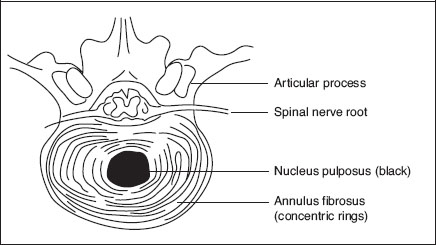Prolapse of intervertebral disks of the lumbar region, or lumbar herniation, is a frequent problem for which patients seek treatment. In Oriental medicine it has three etiologies:
- injury to the local area;
- invasion of wind, cold, or damp to an overtaxed condition; and
- liver and kidney vacuity resulting in lack of nourishment to the channels.
Symptoms include radiative pain of the lower limbs, sensory disturbances to the same area, difficulty lifting the leg, and unilateral or bilateral sciatica. The pain may be severe or worse with lumbar flexion of the low back, and aggravated by a prolonged sitting or standing position in the dermatome area of the affected nerve root.
Normally, the intervertebral disk lies between the vertebral bodies of the spine and forms a mobile joint called a symphysis, which consists of the nucleus pulposus and an annulus fibrosus. The nucleus is a ball of transparent jelly, collagenous fibers, cells and mucopolysaccharides. The annulus fibrosus is made up of rings of fibers oriented in different directions, which surrounds the nucleus with a tough casting. The disks serve as shock absorbers of the forces of compression. The ability of the nucleus to become distorted, and the annulus fibrosus to bend, gives the vertebral bodies the ability to move on each other and to distribute the forces of compression. As we age, the nucleus tends to shrink, to become dry, and therefore less elastic and more fibrous. The annulus fibrosus concomitantly thickens and becomes more prone to rupture.
Technically speaking, a prolapsed disk refers to the herniation of the nuclear material due to tears in the annulus fibrosus. Pain and inflammation develop from pressure of the nuclear material on the posterior longitudinal ligament and the dura mater. The nerve root that can be affected is the one below the vertebra. The vertebral levels most subject to herniation are L4, L5, and S1. If the nerve root becomes affected, pain may be experienced in the corresponding dermatomal area and weakness and reduced reflexes may develop in the muscles. For an appreciation of this problem Figures 8.1 and Figures 8.2 depict a normal and herniated disk, respectively.
The treatment plan for such a condition involves the breakdown and absorption of the herniated nuclear material and repair to the torn fibers of the annulus fibrosus and the posterior longitudinal ligament. In Oriental medicine, an effective treatment strategy for prolapsed intervertebral disks is a prescription called the Eight Needle Technique (see Chapter 6). Eight Needle Technique is a Chinese treatment plan that is typically differentiated as clinically effective for kidney qi and yang vacuity resulting in low back pain. In its totality, it consists of eight points essentially in the local area of the herniation, or points with energetics primarily centered on remediating kidney qi and yang xu (yang vacuity). These points are BL-23 (shen shu) (bilateral), GV-4 (ming men), BL-25 (da chang shu) (bilateral), GV-3 (yao yan guan), and BL-40 (wei zhong) (bilateral). All of the points are located in the standard Chinese locations and needled to the standard Chinese depths of insertion. For clinical convenience, the points, angles, depths of insertion, and energetics are summarized in Table 8.1 and depicted in Figure 8.3.

Stay updated, free articles. Join our Telegram channel

Full access? Get Clinical Tree





